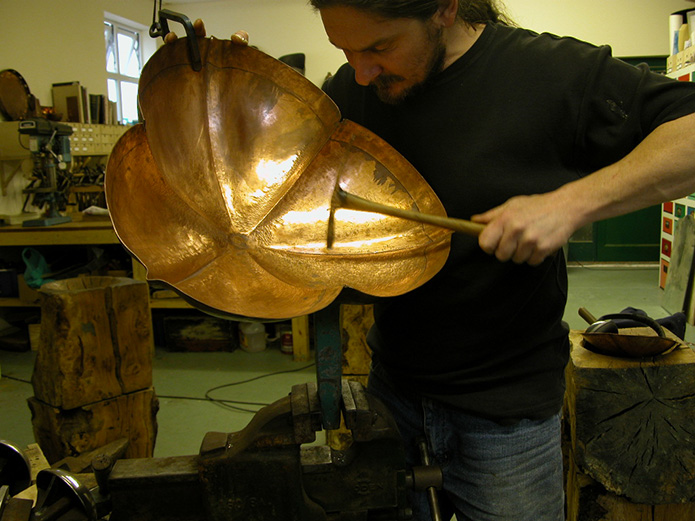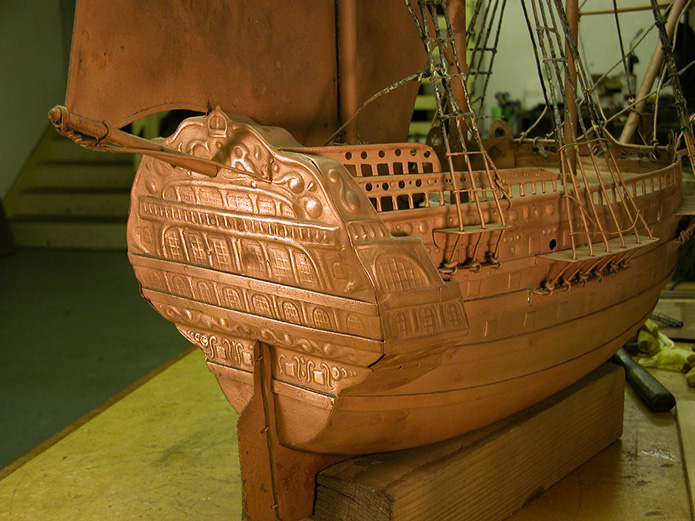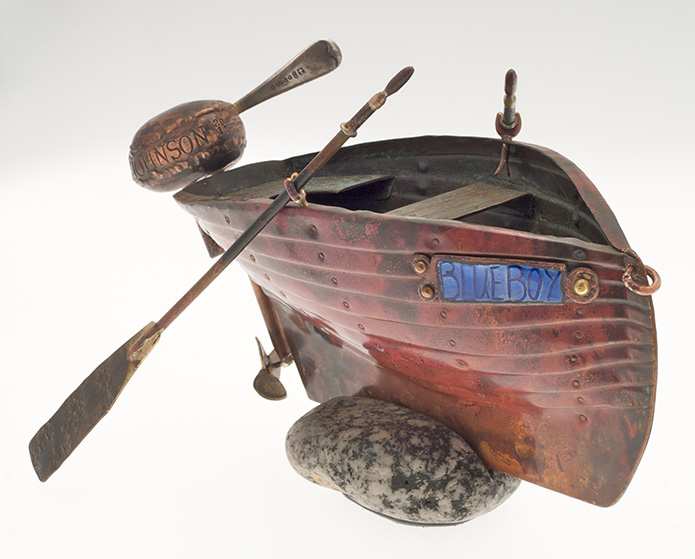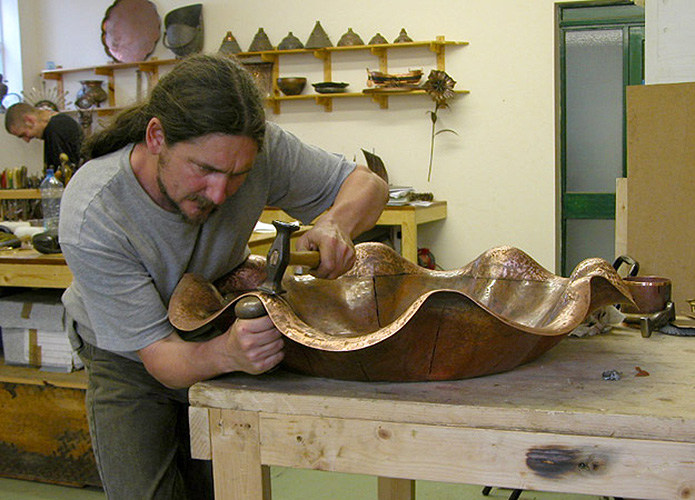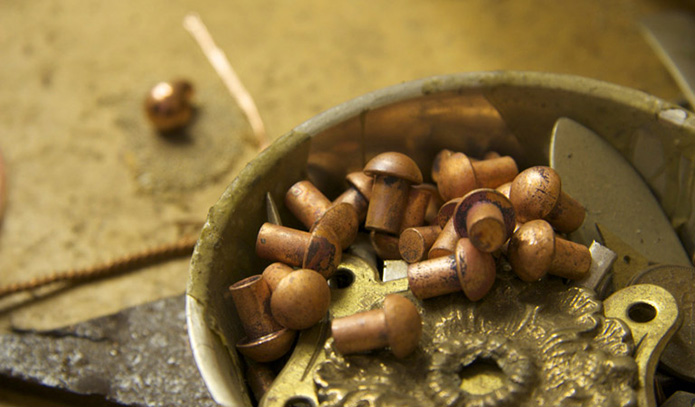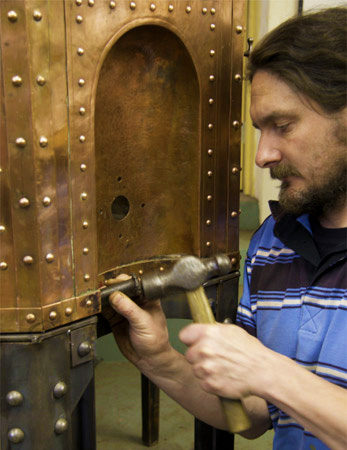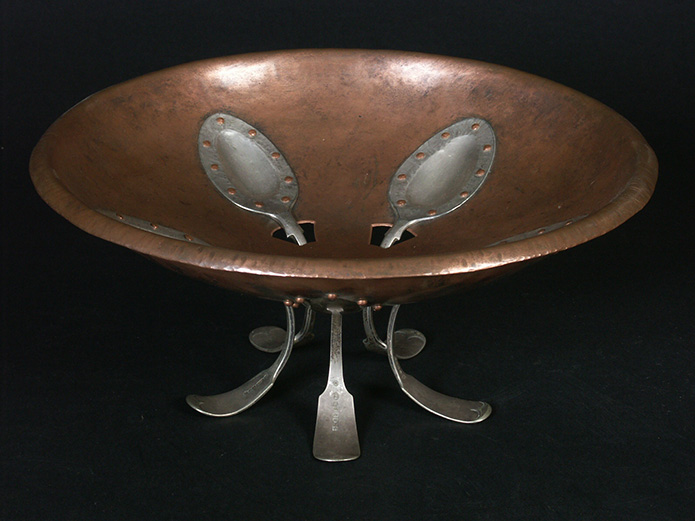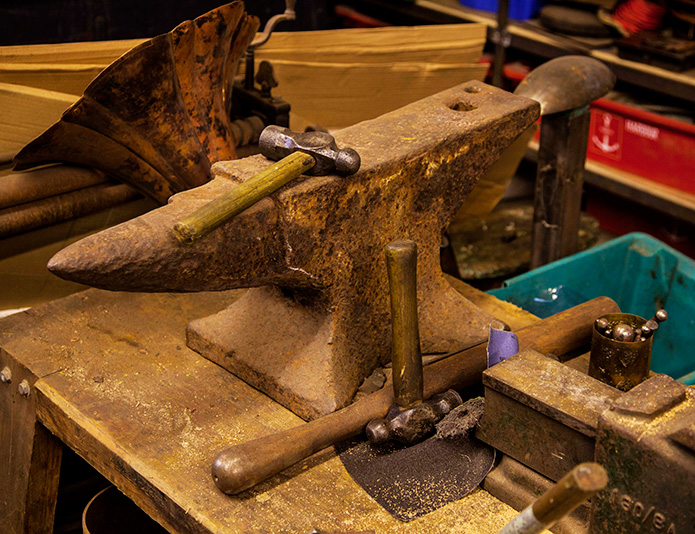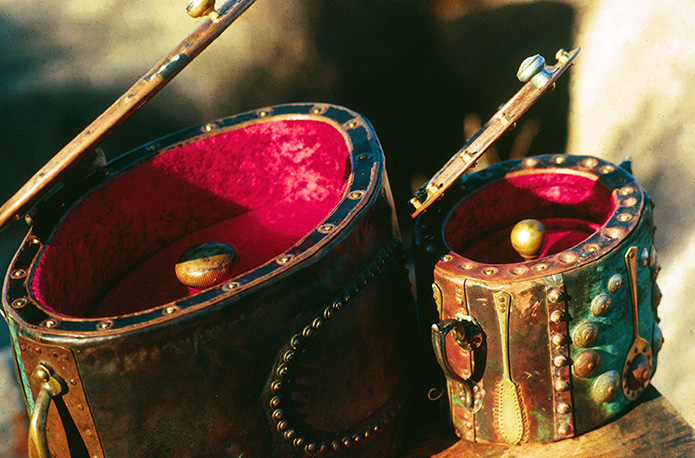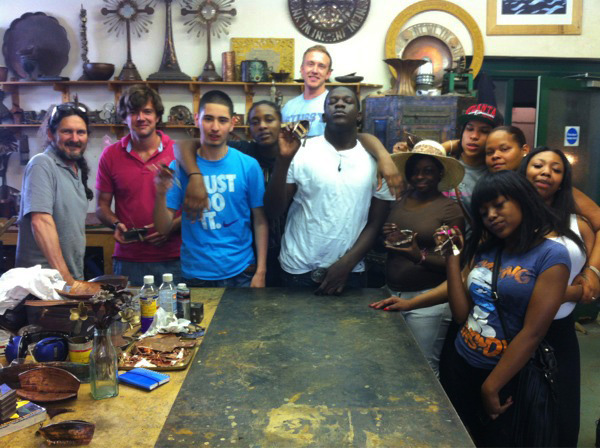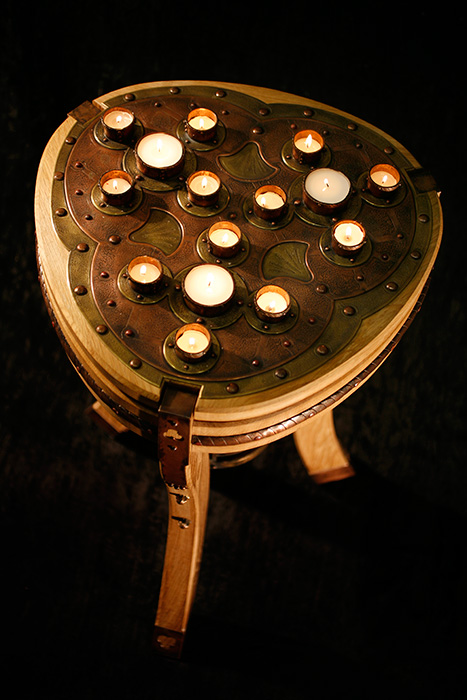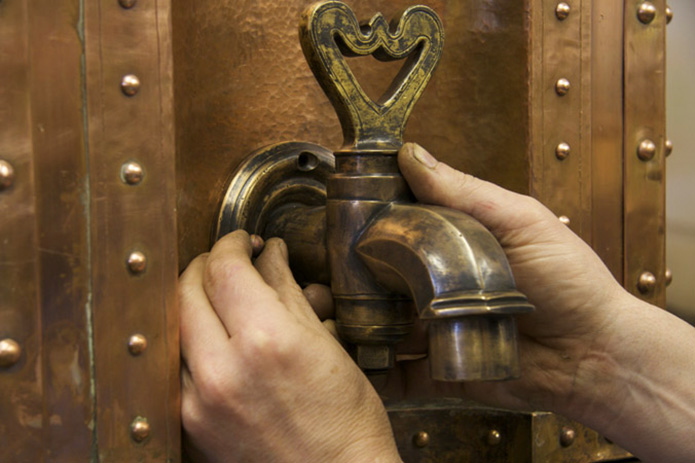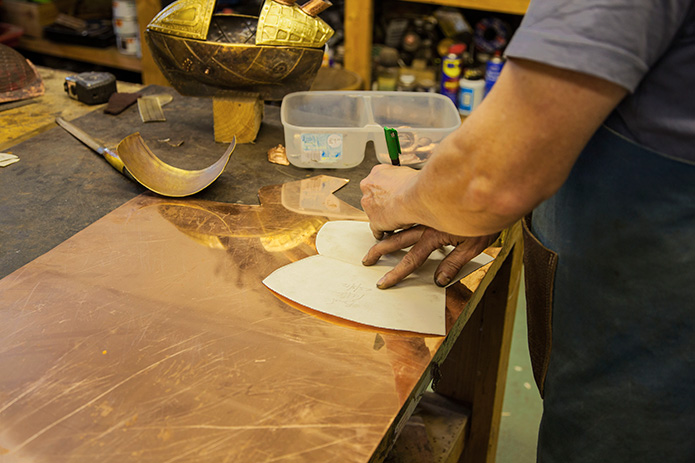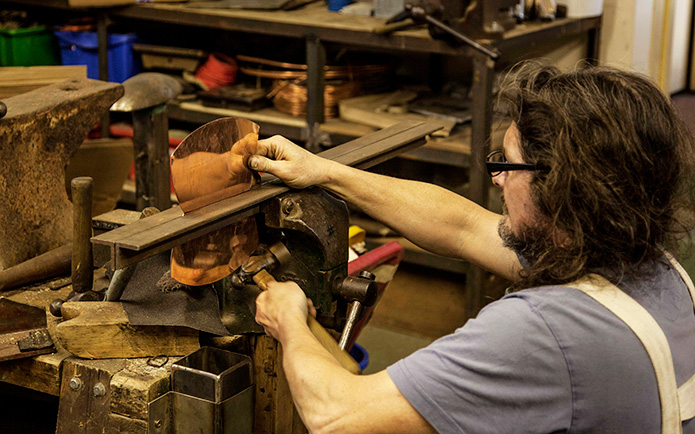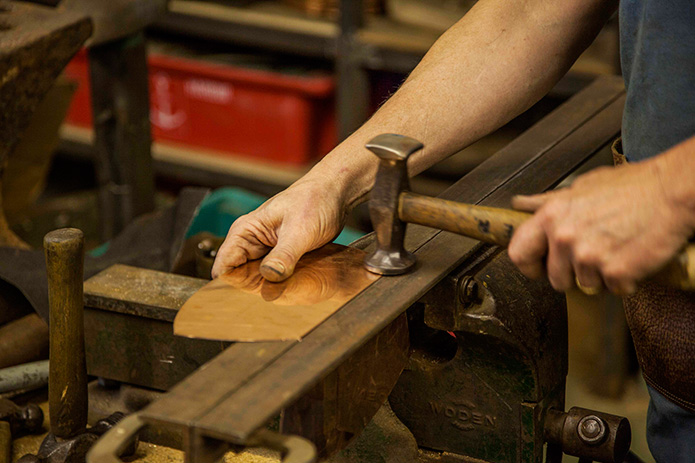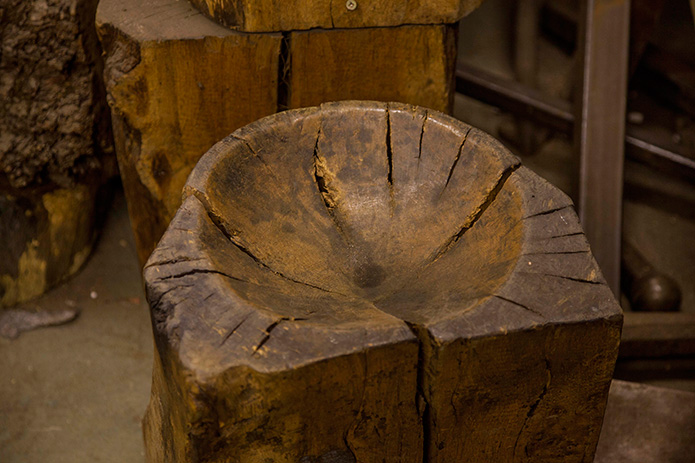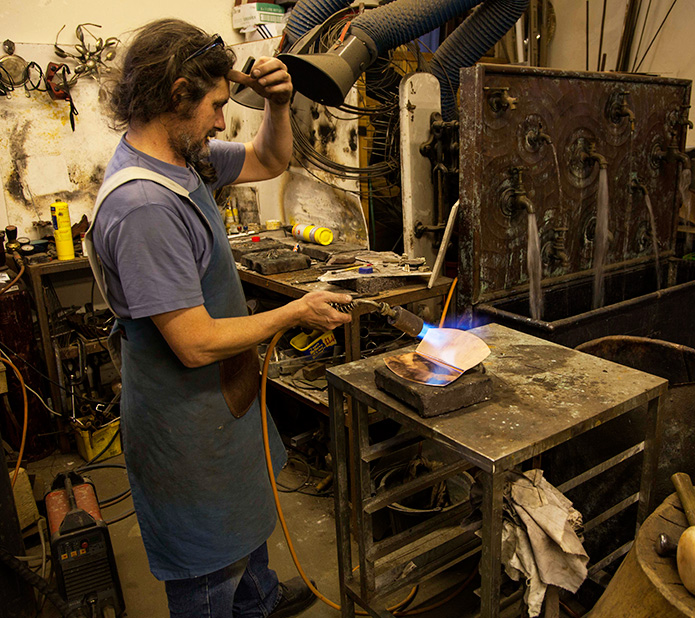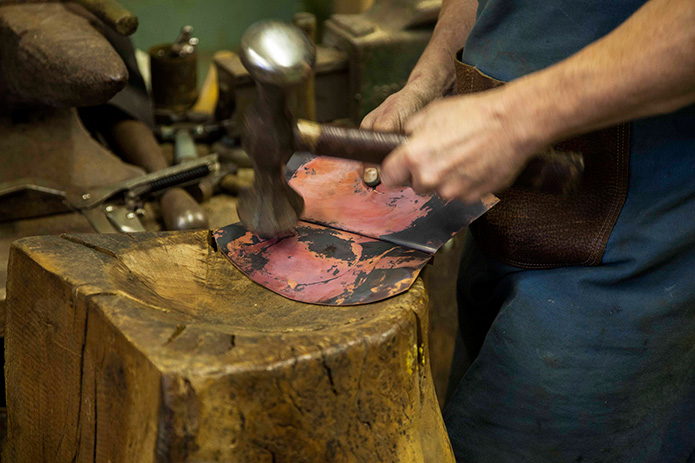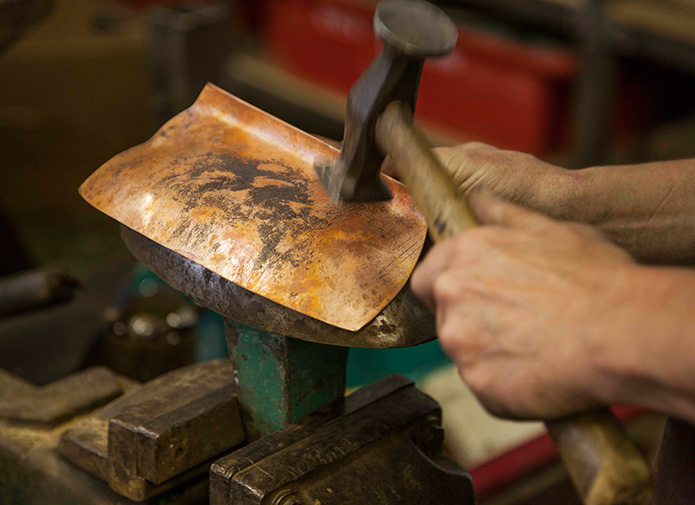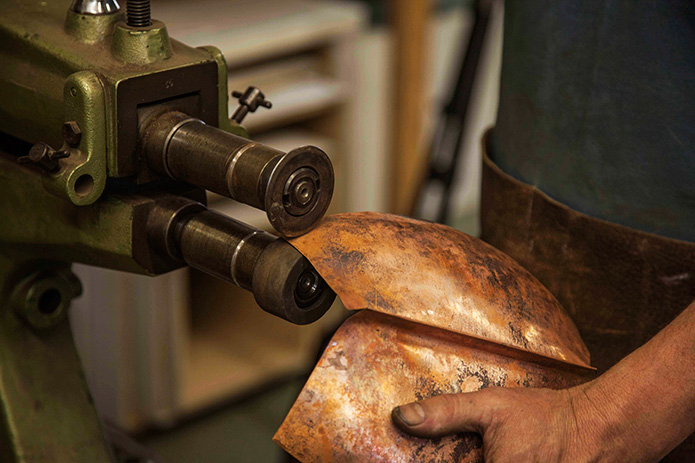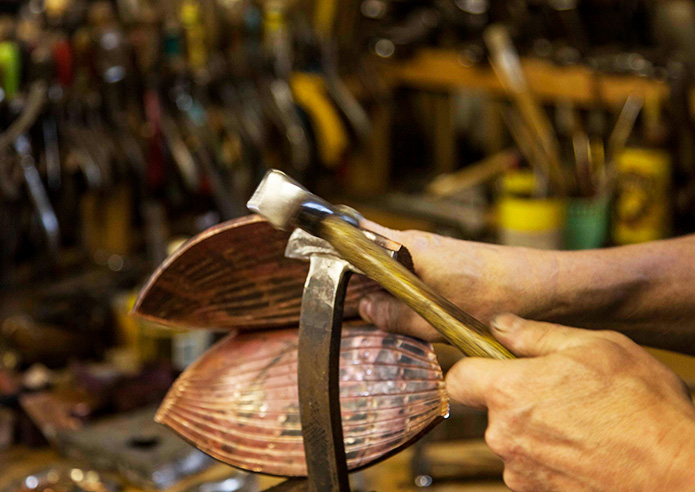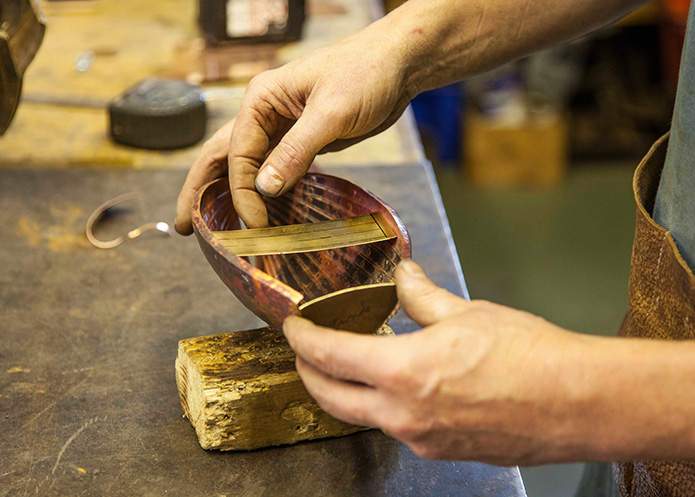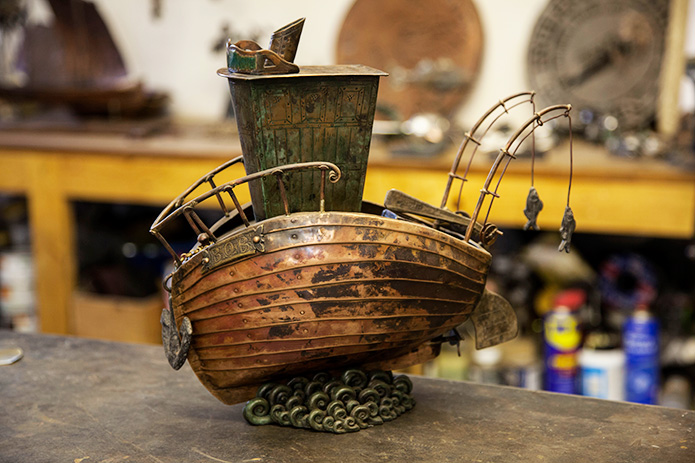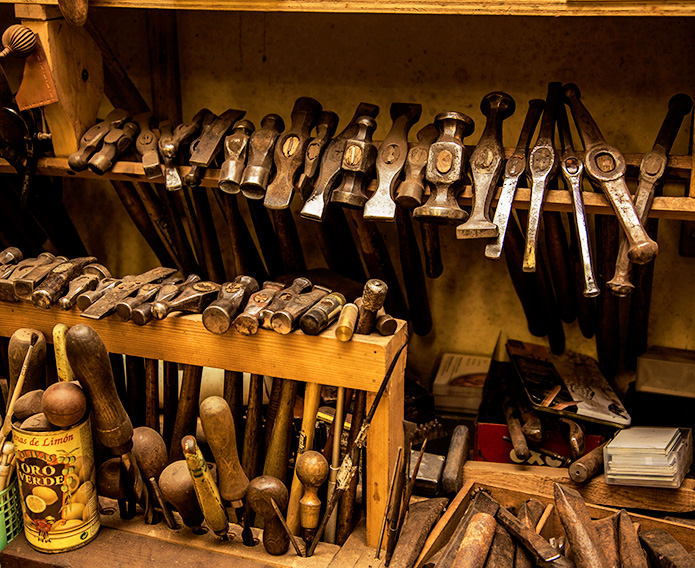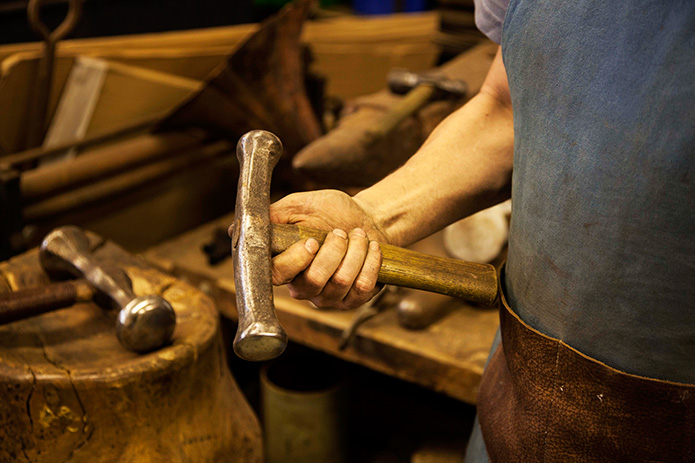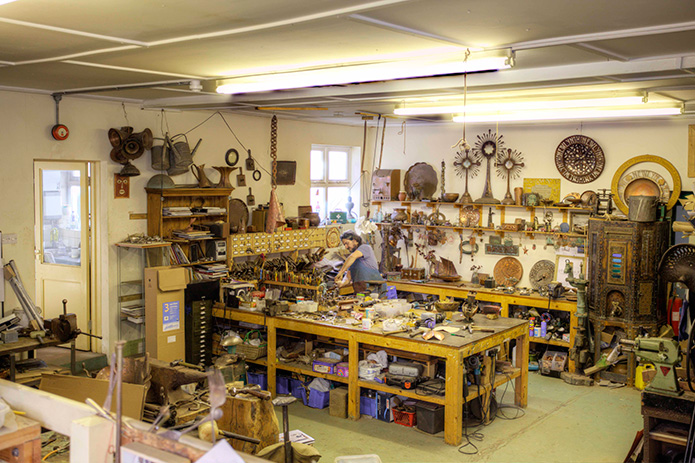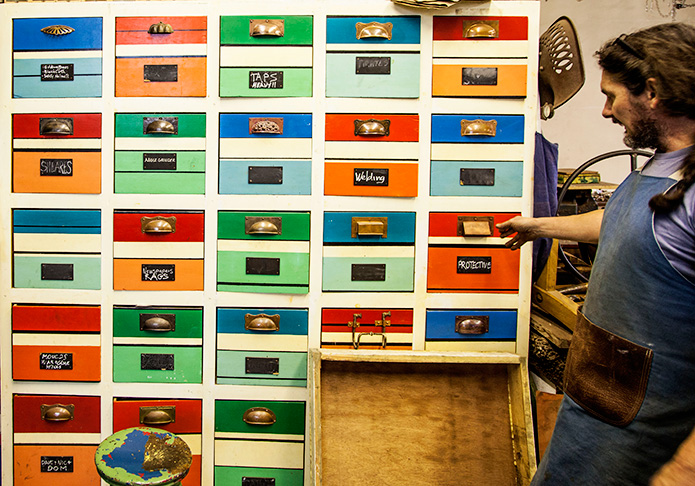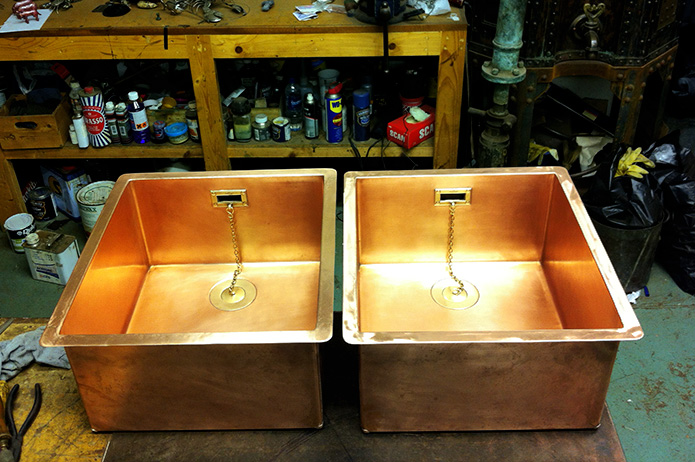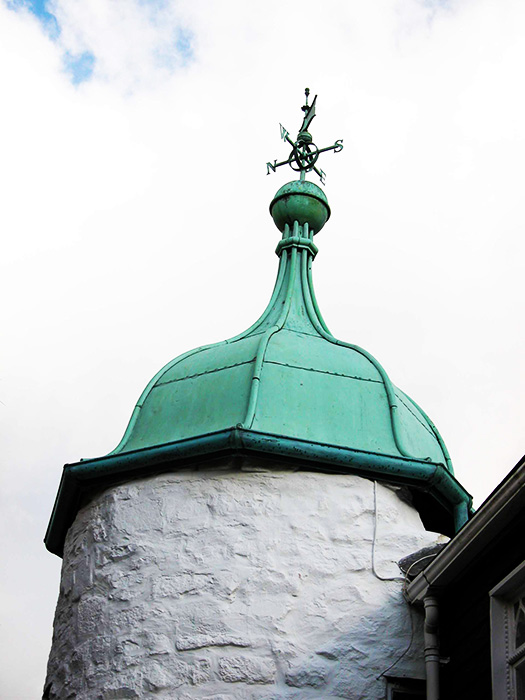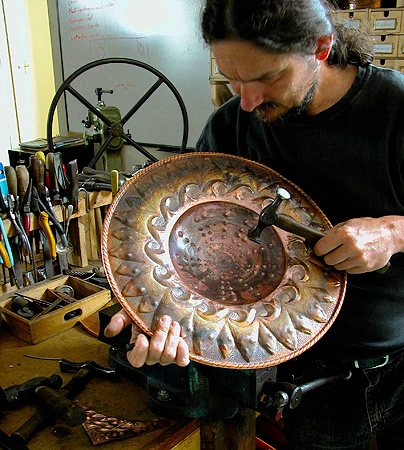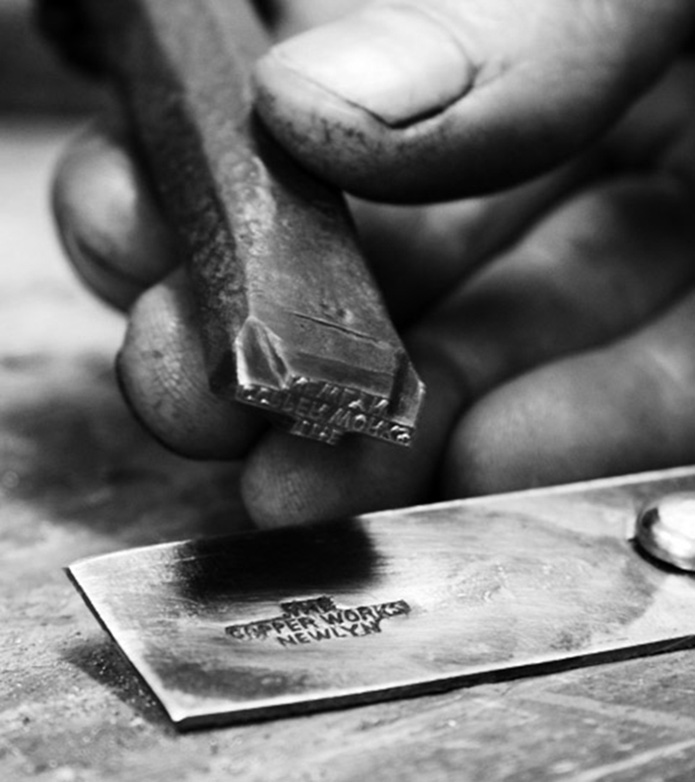
Image courtesy of Michael Johnson / The Copper Works, Newlyn.
I am sure we are all extremely familiar with the term blacksmith – someone who works metal, most notably iron, or a silversmith working with silver, but what about a redsmith? A whatsmith? I thought so, me too. A redsmith is a copper-worker, the term coming from the reddish hue of the metal; another name for the craft is coppersmithing. Although not a word that necessarily trips off the tongue, it is an ancient and traditional craft, being one of the few mentioned in the Bible (Alexander the Coppersmith in the New Testament). These days working with copper has declined since the 1970s, leaving coppersmiths a limited trade, notably copper pipe-working in plumbing and in the aviation industry. However, the global boom in genuine ‘Scotch’ whisky has created demand for authentic copper distilling stills made by coppersmiths in Scotland, and copper-working as a craft and art-form is, thankfully, still practised today by some, especially for jewellery, kitchenware, as well as architectural pieces and restoration.
Michael Johnson is one such creative coppersmith, producing contemporary copper-work at The Copper Works, Newlyn in Cornwall. Newlyn is an area world-famous as a copper centre, both as an area renowned for copper ore production in previous centuries (from the many nearby copper mines around Perranuthnoe, Marazion and St Just), but also for its place within the Arts & Crafts Movement of the late 19th and early 20th centuries; many fine copper pieces (traditionally marine and aquatic-inspired) bear the iconic Newlyn mark and are still very popular today. Much of the Newlyn copper work produced around the turn of the last century was made by fisherman, who were trained in a number of different crafts, including copper-working, when the traditional fishing industry was starting to hit harder times (it is thought the physicality of copper-working, where a lot of hammering is required, as opposed to the more sedentary crafts of woodcarving and fretwork of the day, kept the ‘redundant’ fisherman out of mischief (drinking!) whilst waiting for the fishing to resume during periods of bad weather or barren times).
I had the privilege to interview Michael at his workshop in Newlyn, the busy fishing port in west Cornwall. Let us find out from Michael more about this intriguing and beautiful craft…
ABOUT MICHAEL JOHNSON
Michael spent a transient childhood in North Africa and the Middle and Far East, settling in Australia in the 1970s. Whilst continuing his education to degree level and forging a career in dance, Michael furthered his childhood passion of working with copper leading to exhibiting and commissioning work in the 1980s, resulting in copper-working full-time, bringing the fluidity and beauty of his dancing into the physical art of copper. Returning to Britain to further develop his metalworking skills with world renowned armourer, Terry English (his uncle), hand-forming armour from sheet metal parallels coppersmith and silversmith skills, so it was the ideal ‘apprenticeship’ and Michael had the opportunity to work on such films as First Knight, Joan of Arc, King Arthur and several Pirates of the Caribbean films. Michael established The Copper Works, Newlyn in 2004 having spent the previous two decades collaborating with and learning from a range of craftsmen working in early crafts, ranging from glassblowers to swordsmiths, all with a wide breadth of skills and a passion to draw upon the heritage of their craft and pursue with a particular degree of excellence. Michael also received encouragement and support from the last in the line of the original Newlyn copper workers – John Edgar Laity.
Firstly, for those readers that aren’t familiar with The Copper Works, Newlyn, please can you describe what you do?
We specialise in hand crafting copper and bronze from our workshop in Newlyn, Cornwall. The type of work we carry out is analogous to a blacksmith. We get involved in various aspects that a blacksmith would such as Architectural work, where we create ornate copper roofs and bell towers for instance; Metal Furnishings, such as finials, weather vanes, downpipes, hinges, handles and brackets; Restoration, working on both interior and exterior antique and heritage restoration projects, such as bell towers; Galleries and Commissions, we carry out commissions directly for clients, from wedding gifts to large sculptures, as well as exhibiting in galleries in Cornwall and London; Landscape Gardening, including both functional and sculptural outdoor features, such as trellis, water features and outdoor furniture (I recently completed and installed a large bronze tree with giant spiders web to hang washing on); and finally Interior Design, such as lampshades, lamp-fittings, bowls, vases and so on.
All the items we make in copper are hand forged or hand beaten, although we also make bronze moulds. Whilst we’re based in Newlyn, and inspired by the famous Newlyn copper-workers of the past, we’re not looking to recreate images in the past. We are looking to resurrect the craft of coppersmithing in Newlyn, breathing life into old skills, using old tools, but in a contemporary context.
Having trained in dance earlier in your career, how did you make the transition to become a coppersmith, and what inspired you?
My father was a sound engineer working for the British Forces Broadcasting Station and as a kid I was interested in what he was doing, making and repairing sound equipment working with copper wires, and I would make my own little sculptures from scraps of leftover copper. I was always fascinated with the colour of copper, and thought it was special – after all, it is known as ‘poor man’s gold’ – and I’d make presents to give away.
Even whilst working in dance, in my twenties, I was still designing objects from copper, which I would submit into exhibitions and art galleries; sometimes being commissioned to make some one-off items. By the time I reached thirty, with my body getting completely worn-out from dance I recognised I needed a new career, but I already knew what it would be, as I’d been working with copper as a serious amateur for 10 years, and so working with metal on a professional basis was a natural evolution.
Having a childhood spent in Africa, the Middle and Far East and Australia, what brought you back to the UK, and why did you choose to base your workshop in Cornwall?
I was six weeks old when we left Britain to live abroad, starting out in Tripoli. I then spent my early childhood travelling around the world with the British Forces, before my parents emigrated to Australia when I was 10 years old and I remained in Australia until I was about thirty.
I didn’t actually plan to live in the UK, but there were a couple of factors that led to it happening; one was meeting my future wife here, but the other was my uncle [Terry English] who lived in England, who is one of the foremost armourers for the film industry and he asked me if I wanted to work on a film and invited me over. So what was initially a 3 or 4 month visit to England, has turned into 20 years!
We worked together on films such as First Knight, where we had to create 280 suits of armour, and then mend again after each of the various battle scenes. We worked on Excalibur, where all of the armour was made from aluminium; a fantastically malleable material. The skills for hand-forming sheet metal work in armoury paralleled those of the copper and silversmith, and so I took a lot of valuable experience from the ten years I worked with him. I could have probably stayed as an armourer, but it was copper that was in my blood, which is why I wanted to start the workshop.
I decided to base myself in Cornwall, initially because my uncle lived here; whilst he travelled the world working on various films, for the remainder of the year he lived in Hayle, Cornwall, for the quality of life as much as anything. I met my wife in Cornwall, and there is a rich copper heritage associated with Cornwall, Newlyn and Hayle in particular, so it made sense to remain here.
Some of the best work produced in copper came from Newlyn, and there were some very big boots to fill, and the people from Newlyn are incredibly proud of their copper to this day, and I was inspired to give it a go. I received a lot of endorsement from local craftsmen and women, including the last in line of the original Newlyn copper-workers – John Laity – but ultimately though, they said it wasn’t up to them whether I would make a success of it, but it would be clients to decide; as ‘if they like your work they’ll buy it, but if they don’t, they won’t’.
I feel incredibly privileged to have resurrected the original Newlyn copper workshop, and you can see it means a lot when older people visit the workshop here. Newlyn copper is very special to them, and they have a strong attachment to it; so too the young people of the town.
To provide some kind of context for how big the craft of coppersmithing is in the UK, how many people are you aware of that are making a professional living from coppersmithing in Britain today?
Not an awful lot is the honest truth; certainly not as many as I would like there to be. Coppersmithing can be broken into three areas in the UK: there is the Stills and associated copper work aspect, primarily for the whisky industry, but beer also; there is Restoration, which includes complex architectural work such as statues and buildings, and there is Artisan work, for cultural and decorative purposes. I mainly fit the artisan area, although some Restoration. There are certainly more people that earn a living from industrial copper-working, but coppersmithing as an art and craft-form, there aren’t many people working in it; I would say there are less than a dozen people who make a full-time living from what I do across the whole of the UK. There are, of course, many more people that work with copper on a part-time basis, such as making a simple water feature, but they don’t have professional status and earn a living from it.
Do you feel that, in a way, you are resurrecting a lost craft?
Very much so. If I was starting out learning this trade now, arguably I’d be far better off going to Morocco, France or India, as there are still plenty of places in those countries where still hand forge copper. In the UK though, it has pretty much died a death as a craft.
I feel that I wear two hats: I want to continue the tradition of coppersmithing in Newlyn, but I also want to reinvigorate what copper-working is generally and make it relevant to world today. It’s why I like to open up the workshop to the public to show what we do, and make people aware of the possibilities of what can be made.
Are there any of the original people from the Arts and Craft era – the ‘Newlyn Lads’ – that you admire and draw particular inspirations from?
I admire the Newlyn Lads as a whole; copper-working was a source of income for them whilst the fishing industry wasn’t active, and to learn two crafts at that time was admirable. You also have to put it into context for the wider area, the Newlyn copper ‘industry’ was only one workshop, and it was set up with the best intentions, to enrich people’s lives in and around Newlyn. The workshop moved several times, had different principal craftsmen and there were big fluctuations in the Newlyn fishing industry, and so this impacted on the available copper craftsman, so the whole Newlyn copper industry was a fairly fluid scene, without a permanent and extensive base like in Normandy in France where there are several workshops in close proximity of each other; so it was a testament to the people involved that it survived for as long as it did.
Individual ‘metal heroes’ for me are quite numerous. J.D. Mackenzie was very influential for the Newlyn copper industry; not as a copper-worker, but as an illustrator who would send designs for the copper work. He was very adept at creating images that were sympathetic to repoussé work. A lot of Newlyn copper designs were influenced by Mackenzie and, of course, he was responsible for setting up the workshop in the first place all those years ago.
I admire John Pearson greatly because of the way he was able to interpret ancient themes into copper, but also some of the techniques that he brought into copper-working to speed up the process, such as the lead block technique, whilst remaining extremely sympathetic and forgiving to the metal.
Obed Nicholls was a fascinating individual. He contracted polio as a child and couldn’t walk. Some of the other Newlyn Lads made him tools so he could work from home; at one end of the kitchen table would be his sister making Cornish pasties to make a living, and at the other Obed would be hammering copper. I rate him very highly, not just because he was disabled, but because his images of dog sharks in copper are second to none.
Finally, Reggie Dick deserves a mention; he produced the most exquisite enamel and copper jewellery, although he also worked in silver as well as copper.
The original Newlyn Copper Works went through a lull in activity in the middle of the 20th Century and eventually closed in the 1950s. What were the reasons for this, and what lessons can be learned from this for new generations of craftsmen and women in the 21st Century?
Don’t send boys to war would be my first answer! Several of the Newlyn Lads died in both the First and Second World Wars, including JD Mackenzie who died as a consequence of his injuries sustained on the battlefield. A tragic shame.
The prominence of plastic, Formica etc, and the rise of mass-production, meant that people weren’t interested in the ethos of handcrafting inspired by the likes of William Morris, and the copper industry in Newlyn, and elsewhere, dwindled away.
There has definitely been a resurgence in arts and crafts in recent years though, and people are more conscious of the heritage, integrity and sustainability of products they buy. Such is the demand and interest in the workshop, I could probably extend it to twice the size it is today. Young people, especially, are really interested, and I’ve had lots of school children attend workshops; lots of interesting copper boats are created, keeping alive the original Newlyn tradition, and one student even made a copper case for his mobile phone!
Tradition is important to connect the past with the future, but making traditional items for traditions-sake is probably not the way forward in my opinion. I think items need to be given a contemporary context; there’s no point just making a candlestick – it needs to have functionality and design embodied within it. If we ever reach the point whereby we’re not interested in handcrafting, we may as well all go out and buy 3D printers.
France and Belgium have a strong tradition of making tin-lined copper cookware items; given the abundance of tin and copper in Cornwall in particular, why do you feel that Cornwall didn’t become synonymous as a region for making copper cookware?
I think one of the reasons is that the British are adept at moving forwards in working in metal. Why work in copper when you can work in iron, or aluminium! The French, on the other hand, stick closer to their heritage and continued making items from copper. There are pros and cons of each approach, of course.
The other reason though, and probably the main one, is that whilst Cornwall was a prolific producer of copper and tin ore, the smelting and processing of the ore took place elsewhere, mainly in Birmingham, closer to the source of coal and for centralised distribution. There is a general misconception that copper was made in Cornwall; it may have done in small-scale foundries many hundreds of years ago, but the copper that was used in the past couple of centuries was bought in as half hard, cold rolled sheets from more northern suppliers. It’s the same as where I was brought up – in Australia – where vast quantities of ore are mined, but instead of adding value roughly in situ, it’s sold abroad where the ‘added value’ takes place, and then it’s bought back from them. We need to ensure that in Britain, that we never lose our propensity for manufacturing and production.
Could you talk through the process of how you complete a simple project, such as making a copper boat, from taking the raw material and turning it into the finished article?
In general, most of our work starts life as a sheet of copper, with a thickness ranging from 0.7mm to 1.5mm, which we hand beat to make a 3D object, although we do sometimes cast bronze. For a copper boat though, this would be made from a sheet of copper, either new or where we can get recycled copper from a scrap yard.
We cut the copper to create the desired shape by using a paper template on the sheet and mark on the copper with a pen which we cut out with shears or sometimes an angle grinder.
We then take the shape and folding it in half by accurately folding it in half by fixing it in a vice.
Using a hammer, we then fold the copper over to form the two sides of the boat.
The copper shape will be inserted into a wooden block called a ‘former’ which has been hollowed to the shape of a bowl (we have several of these of different shapes and sizes).
Before we insert the disc, however, we need to change the properties of the copper slightly by a process called ‘annealing’. If we didn’t anneal the copper before working on it, then the repeated hammer blows would make it susceptible to cracking or breaking, as the hammering makes the copper very hard, and the annealing softens it. We anneal the copper by using a gas torch to heat it up so it’s red hot, then we put it in water, which softens it and makes it easier to work.
Once the annealed copper is hammered into place in the depression in the wooden former using a hammer or mallet, we’re able to shape the boat by hitting the copper with a series of overlapping blows from a round headed hammer into the hollow of the wooden block until it forms a bowl shape, where it is stretched and thinned. You’re then left with a wrinkled and bumpy looking boat; the wrinkles are a result of the circumference of the copper decreasing as it takes on the rounded shape.
We then take the boat and flip it over onto the anvil mandrel, and then using metal or nylon planishing hammers we carefully remove the lumps by beating the surface with gentle, glancing blows until it’s perfectly smooth; a process known as planishing. If this is done correctly, the surface will be true and bright and covered with brilliant facets. If the metal looks as though it’s hardening too much to be worked (and become brittle), it will need to be annealed again to make it soft.
We then add in detail using repoussé techniques to the outside of the boat by shaping the reverse side of the copper using special tools. To create lines in the copper to mimic wooden panelling, we run the copper through a specialised machine.
The edges of the boat may be slightly ragged, and if so we take shears to cut the boat sides to shape and then file the top with a smooth file; we then add the rim. Using a raising hammer to hammer the outside edge of the boat to flatten it out, we then use the ball peen side of a chasing hammer to create a rounded shape to the outside rim.
We then assemble the boat and add in the necessary detail as required, such as cabin, fishing rods, propeller etc, and then it is placed on a cast bronze stand in the shape of a series of waves.
We then focus on the colour and finish of the copper, by bringing up verdigris of the copper, which is the green pigment associated with the ageing of copper plate, by oxidising it with acetic acid which speeds the whole oxidising process up. We can vary the final colour of the copper by the amount of oxidising that takes place. To finish with, we add wax to the copper to protect it.
What I’ve described is a very simple process, but it’s the same basic principles that apply for most of our work; the sails for a boat, for example, are dished in exactly the same as the way as a boat is made.
I understand that you make your own coppersmithing tools, is this because modern tools are inferior, or there just aren’t the specialist tools out there that you require?
I think both are true. It can be really difficult to find good tools for coppersmithing, but there is a lot of crossover with blacksmiths tools which helps for some situations.
A lot of the problems arise from finding tools of the right length or depth – a short hammer just isn’t suitable for a deep vase, and a narrow vase also causes a lot of problems as there isn’t the room to swing the head of a normal sized hammer, for example. Many a time I’ve had to cut off the rear half of a hammer just to be able to swing it properly!
The key to copper-working is to keep the copper moving, make it fluid, so that it can stretch. Specialised tools are needed to help this, but they’re not really out there. Of the modern coppersmithing tools, I find the Swiss and German tools are the best, such as Grobet, but a fair amount of my tools are 300 or 400 years old; the quality of the tools, and the shape of them, is perfect for what I want, as there’s no wasted energy in swinging the hammer. They certainly knew what they were doing in those days and it was very common for coppersmiths in the past to make their own tools. It’s amazing to think that the toolmakers of hundreds of years ago that made our tools wouldn’t have a clue what we’re using them for today; that’s part of the beauty of it for me.
Are there recognised training programmes for people wanting to embark on a career as a coppersmith, and what advice would you give to someone looking to get started?
Unfortunately there aren’t any specific coppersmithing courses available, as far as I’m aware, but there are Fine Art metal and sculpture courses that could be relevant. Art colleges and Universities offer courses in blacksmithing and silversmithing, and there are in fact a lot of parallels with these crafts and coppersmithing, so this could be a route. Copper and silver are very similar and share many of the same properties (although silver is a little softer), and in fact, early student work on silversmithing courses is carried out on copper, due to cost, as they work similarly. It could be possible to train as a silversmith, and then apply the skills learnt to copper afterwards. Likewise, it may be possible to train as a blacksmith, and then cross-over into copper afterwards.
The other option would be to apprentice with a firm making whisky stills, or carrying out structural or pipework, and then make a transition at a later date.
Apart from that, there’s not a lot available. It’s one of the reasons why I’m looking to expand my workshop into teaching, to provide opportunities for people to train. I’ve spent a lot of time learning my craft, and I’m passionate that the skills can be taught – after all it’s not that specialist, it’s just that it’s not very common and people aren’t aware of it as a career choice.
What are your thoughts on the future of the craft of coppersmithing?
The most comprehensive area of growth in coppersmithing in the UK is make stills for the whisky industry in Scotland. The growth in demand in China, and throughout the growing industrial countries, has seen a huge demand for authentic Scottish whisky, made from authentic distilling stills. Thus copper stills are being made at a greater rate than ever and the craftsmen who make them are passing on their trade to a younger generation, so from that perspective, the craft is in safe hands.
Still-making aside, I’m not so sure what the future holds for coppersmithing as an art and craft-form; it’s a Catch 22 situation. If people don’t know copper items are available, they won’t go looking for them. I think it’s important to spend time educating people, showing what can be done, what the possibilities are. It’s why I open my workshop up to designers, for instance, to see what we do here, but anyone is welcome.
Copper is such an interesting metal. Aside from its aesthetic qualities, it is also very hygienic, and I think for this reason alone, copper as a metal will continue to be used for its antibacterial properties. Tests have shown that in hospitals, tap and door handles made from copper significantly reduce bacteria spreading; it’s the same reason why copper was used as an anti-fouling measure on the keels of boats in previous centuries to stop molluscs etc growing there. As copper has the potential to save lives, I can see it being used more-and-more on things that come into contact with our hands, such as handles and soap dispensers. How this impacts on coppersmithing as a craft, I’m not sure. We do industrial art here in Newlyn, but not industrial manufacturing, but there’s got to be possibilities…
As for coppersmithing in Newlyn itself, the people here love their copper, and it’s part of the heritage, and I think there’s demand and interest to keep it going. One of my ex-students is now a jeweller in Newlyn, and we have lots of other youngsters coming through the workshop on a Friday after school and Saturday morning who show promise, so I feel confident it will continue to the next generation.
What more do you think the Government could do to help support traditional crafts to ensure their survival beyond the current generation?
I’m not really on the political coalface, so I’m not sure I’m qualified to answer the question. I do think, however, that we have such a rich heritage in Britain, both craft and art, that we need to protect this; it’s what drives visitors to come here and witness the heritage all around them, whether that is thatched roofs, historic buildings, artisan food producers, or whatever. We need to celebrate that and ensure crafts survive for future generations, otherwise, who will be preserving and restoring all our fantastic old buildings etc in the future?
I think invention and design are the backbone of the UK, or certainly were once, and they need to be going forward. We should be able to combine traditional crafts with contemporary functionality, and push these products not just in the UK, but internationally and the Government should certainly play its part in actively supporting all initiatives that help with this. Take the Olympic opening ceremony as an example; we could all witness the creativity and inventiveness, and it was a joy to watch. We must find a way of keeping the heritage alive.
Many thanks to Michael Johnson for taking time out of his busy schedule to answer our questions. For more information on coppersmithing by Michael Johnson and The Copper Works, Newlyn, or if you’re considering commissioning a project, please visit Michael’s website by clicking the link below:

